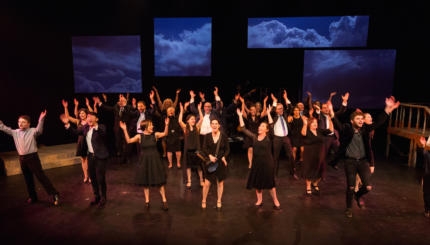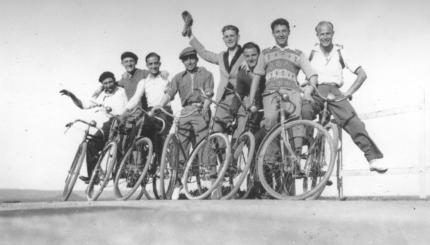From painting to sculpture to video and performance art, contemporary Israeli artists are, increasingly, ambassadors of a national culture and identity. From the bi-annual pavilion at the Venice Bienale to the white-box galleries of London, New York, Paris, and Tel Aviv to the generous circuit of juried international shows and art fairs across the world, contemporary Israeli artists are innovating and building on an artistic legacy rooted in Jewish history and identity, the land of Israel, and the encounter with various modernities.
Mediating the Past
The Holocaust is a powerful inspiration for many artists working today. Many have translated their emotional response to trauma and tragedy into the visual language of abstraction, as both a pure expression of spirit and as an adherence to the biblical prohibition on representative images. As abstract expressionism gained favor in Europe and America, its innovations were harnessed by Israeli artists for cathartic, rather than formalist, purposes.
Moshe Kupferman (1926-2003) employed muted colors and geometric formations in his paintings to conceal and reveal aspects of his experience as a survivor of the Polish camps. Moshe Gershuni (b. 1936) began his career as a conceptual performance artist, singing prayers at galleries and museums, but gained renown as an expressionist painter whose works deal with biblical themes and religious belief. Michael Gross (1920-2004) also took up the task of translating religious pathos in his sculpture and painting, with great sensual effect. Considered one of the greatest painters and sculptors of modern Israeli art, Gross developed a type of minimalism strongly influenced by natural form and the ethos of the Israeli landscape.
Figurative Painting
There is still a strong school of figurative painting in Israel that builds on the rich landscape tradition of early Zionist artists, who linked the beauty of the terrain to their destiny to occupy the land of their ancestors.
Israel Hershberg (b. 1948) is a supreme naturalist, painting highly detailed landscapes infused with Mediterranean light and a patina of desert dust. His close examination of cypress trees creates portraits of iconic green sentinels on the horizon. Menashe Kadishman (b. 1932) has painted a great range of subjects, but his consistent use of images of sheep, often in a colorful, pop style, have become symbolic of the Israeli identity struggle–between a pastoral, nomadic heritage and a sad history of victimhood.
Tsibi Geva (b. 1951) uses everyday symbols and ornamentation of Arab and Israeli life in a style that is both abstract and figurative. In the 1980s, his paintings depicted the names of Arab and Jewish cities in Israel, asserting an overtly political message about authority and territory. His more recent works manipulate patterns from everyday objects signifying Arab identity such as backgammon boards, kaffiyehs, and floor tiles. David Reeb (b. 1952) also addresses Arab and Israeli opposition, perhaps more overtly than other prominent artists, employing irony and the tactics of advertising in his beautifully rendered paintings. The monochrome Let’s Have Another War (1997) was his entry for Documenta X in Kassel, Germany and was based on photos of Israeli-Palestinian conflict.
New Media
A younger generation is eagerly embracing new media and developments in art practice to explore a variety of themes. Many successful artists from Israel train initially at the renowned art school in Jerusalem, Bezalel, but leave the country to pursue graduate fine arts training in Europe or the US. Some then stay in their adopted countries, representing Israel from an expatriate position.
Ori Gersht (b. 1967) photographs Israeli landscapes with an eye more for poetics than photojournalism. His smeary, blurred depictions of olive trees and the Judean desert also seem to draw forth the mystified past of the land. Adi Nes (b. 1965) takes up the same subject matter, but focuses his lens more with the precision of a documentarian, often posing subjects in elaborate tableaux. In Untitled (1999), Nes recreated Da Vinci’s Last Supper using Israeli soldiers as models. Sharon Ya’ari (b. 1966), winner of the 2006 Israel Prize for outstanding visual art, photographs ordinary landscape scenes that hint at an undercurrent of anxiety always present in Israeli society during precarious times.
Addressing the Occupation
In the wake of the second intifada, several young artists have begun to critically address the Israeli occupation of Palestinian territories. Part of the generation disillusioned with the practices of conscription military service, Yael Bartana (b. 1970) addresses militarization as a way of life that all Israelis know. Her video works, Trembling Time and Disembodying the National Army Tune play with notions of allegiance and national remembrance of military victories.
Michal Rovner’s films present a critique of military dominance over Palestinian territories. Employing a sentimental, self-involved narrative style, Rovner (b. 1957) documents her perception of injustice along state borders. Sigalit Landau (b. 1969) broadens the debate about difference and dominance with her conceptual and sculptural works. She transforms cargo containers into provocative spaces of refuse and refuge, underscoring themes of nomadic desert life and homelessness–both Bedouin and Jewish. Growing up in a Bedouin village in Galilee, Ahlam Shibli (b. 1970) documents Bedouin communities that the Israeli government has relocated from their traditional lands into public housing. She has also documented the potentially paradoxical service of young Arab men in the Israeli army.
Working with raw news footage and special effects, Doron Solomons (b. 1969) is at the forefront of video art. His works address the violence of everyday life in Israel along with the heartfelt wish for a better, magical future. He and other emerging video artists work in a “no-frills,” low budget style, often using their own homes and family members to set the scene. Guy Ben-Ner (b. 1969), chosen to represent Israel at the 2005 Venice Biennale, creates imaginative worlds from home-made materials, and often casts his young children as characters in his absurd make-believe mini-movies. Tamy Ben-Tor (b. 1975) adopts the amateur video style as well, inserting cutting cultural commentary through the articulate voices of various controversial characters–all of them played by herself.
The Scene
In the past two decades, several non-profit institutions have emerged to support contemporary Israeli art. In Israel, the national museums in Jerusalem, Tel Aviv, Haifa, and Herzliya regularly feature shows of contemporary artists, while in the US, many metropolitan Jewish museums have developed specific galleries and programs to display and encourage dialogue about today’s Israeli art.
Yet the contemporary Israeli art scene is still firmly rooted in secular Tel Aviv, where artists work in studios located in the city’s southern industrial districts and dealers establish galleries near fashionable shops and restaurants downtown.
Moshe
Pronounced: moe-SHEH, Origin: Hebrew, Moses, whom God chooses to lead the Jews out of Egypt.


